You can ask almost anyone, and they’ll tell you that the island of Hawaii is one of the most gorgeous places on the face of the earth. It’s covered in stunning palm trees and amazing wildlife, and the people there are as nice as can be. There’s also a lot of fun to be had in the ocean, so whether you love to surf, swim, or snorkel, you’re sure to have a blast. However, you must be careful to avoid some scary creatures that could cause you harm, or you could put your life at risk. Next time you’re on vacation, beware of these 13 most dangerous animals swimming in Hawaii’s oceans.
1. Long-Spined Venomous Sea Urchin

The
sea urchin
looks beautiful but it can be quite dangerous as well.
©NatalieJean/Shutterstock.com
When people think about the most dangerous animals swimming in Hawaii’s oceans, they typically think of sharks and wild creatures, but sometimes, it’s what can appear harmless that can cause the most pain. In this case, we have the long-spined venomous sea urchin, which lurks at the bottom of the Pacific Ocean. The problem is that you’ll find this urchin in many places populating the ocean floor, so it’s very possible to step on it if you’re not paying attention.
Although it won’t kill you, stepping on the urchin will release venom in its spines that can be extremely painful. Even worse is when one of the spines breaks off in your foot or leg, and it can be very difficult to remove. If anything, the spine will eventually dissolve, but it takes time. Always wear water shoes or other protective footwear while in the water, and if you are stuck, then use warm water and vinegar to ease the pain.
2. Box Jellyfish
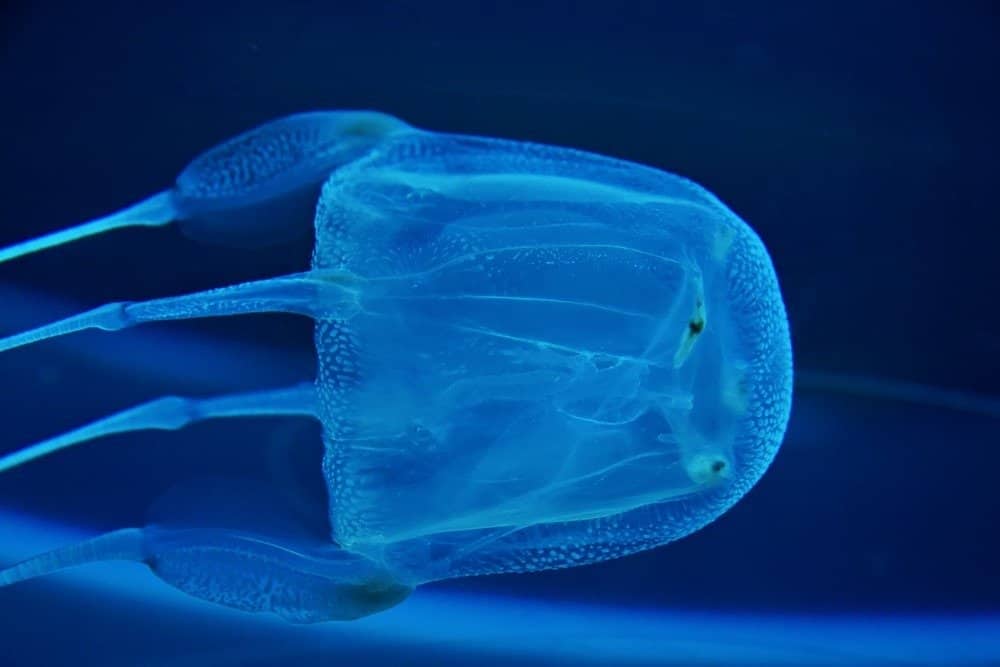
The box
jellyfish
can grow up to 10 feet in size!
©Daleen Loest/Shutterstock.com
While they may look beautiful while floating in the water, the box jellyfish is one of the most dangerous animals swimming in Hawaii’s oceans, and it can also be lethal. They also live in the Pacific Ocean and you may also know them as marine stingers or sea wasps. You’ll know to stay away when you see their cube-shaped bodies. They can grow up to 10 feet in size and they seem to float out of nowhere.
On each monstrous jellyfish, there are close to 5,000 stinging barbs. The purpose of the barbs is to help them feed on shrimp and fish. They catch their prey with that venom. If you are ever stung, then you can be so filled with toxins that your heart will stop, your nervous system will go on the fritz, and your heart could fail in moments. Unlike other jellyfish that seem to just float around willy-nilly, the box jellyfish swims in intentionally, and it may come after you. That’s why many beaches are closed for the day when a lifeguard spots them nearby.
3. Cone Snail
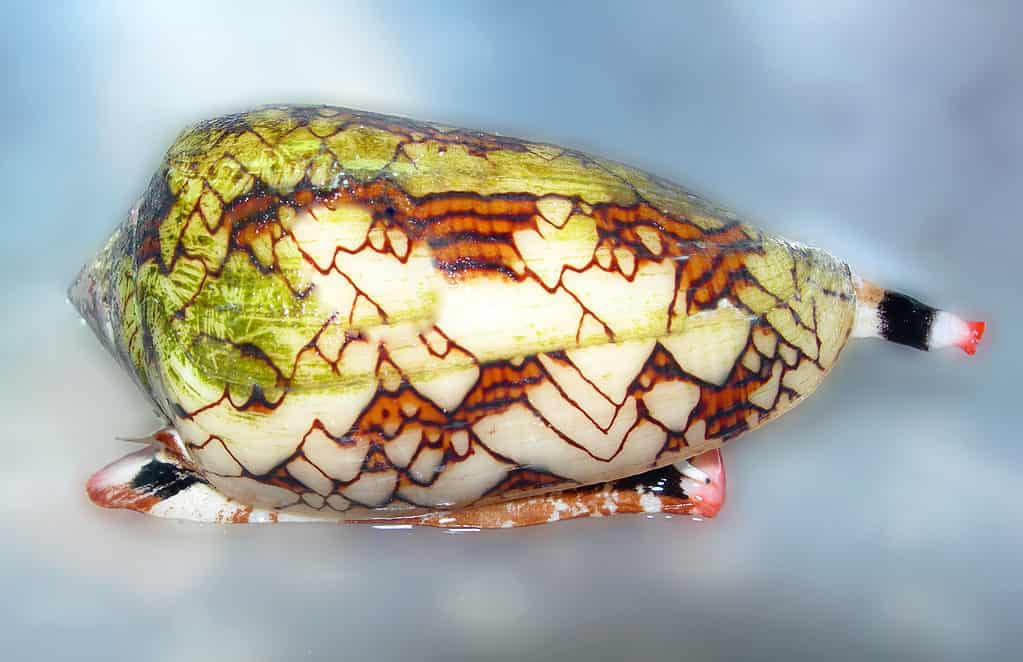
The cone snail looks unassuming but it’s also very lethal.
©O’KHAEN/Shutterstock.com
This is another case of a small creature causing major harm. In this case, it’s the various versions of the cone snail that inhabit the water around Hawaii. There are many different species of cone snails, and 34 of them live around the island. The cone snail is very toxic. The most dangerous species have venom that can induce anaphylactic shock and death in humans. The three most dangerous varieties in Hawaii are the Striated, Textile, and Branded Marble snails which have enough venom to kill 10 humans.
The snails are particularly dangerous because, unless you know what you’re doing, it’s almost impossible to know what you’re about to get yourself into. The snails have gorgeous patterned shells that can catch your attention. Many people, including children, are tempted to pick them up and bring them home, and that’s when they strike.
4. Great White Shark

Great white sharks are famous predators but they don’t really mean you harm.
©iStock.com/Martin Heyn
If you see a great white shark in the waters of Hawaii, then there’s no mistaking the fact that you’re in trouble. Not only is this one of the most dangerous animals swimming in Hawaii’s oceans, it’s one of the most dangerous creatures in the entire world. The only good news is that his shark is not as common as some of the other animals on this list. On average, these amazing sharks grow to 15 feet in length, and many are up to 5,000 pounds. That’s a lot of weight bearing down on you. What’s worse is that the shark has up to 300 teeth that are razor sharp.
Of course, the great white shark doesn’t intend to hurt humans. Its primary diet consists of sea lions, birds, crustaceans, seals, other sharks, and small orcas. Sometimes, a great white will attack a person because it thinks it sees a seal flailing around. In other cases, the great white might take a small bite out of a person to determine if they’re worth eating. That’s why although there are fatalities, most people survive their ordeal with the great white shark. However, it certainly is frightening, and you could lose a limb in the process.
5. Tiger Shark

The
tiger
shark can grow up to 13 feet long, but luckily it doesn’t attack people very often.
©le bouil baptiste/Shutterstock.com
If you’re going to see a shark, it’s more likely that you’ll see the tiger shark more than the great white, but either encounter is very dangerous. The tiger shark can grow up to 13 feet in length. They get their name due to their blunt snouts and tiger stripes on their bodies. Tiger sharks also don’t prioritize humans when it comes to their feedings because they have a similar diet to the great white. However, the problem is that once the tiger shark takes a bite, it doesn’t always move on, and an encounter with a human can be deadly.
The good news is that the numbers are on your side. Since 1828, there have only been 11 tiger shark fatalities, and most of those were closer to Maui. Still, you don’t want to be a statistic. Always follow the instructions of the lifeguards and never go swimming alone.
6. Moray Eel

Moray eels are scary creatures and they are also large, growing up to 13 feet long.
©iStock.com/Vitalii Kalutskyi
It’s not the first sea creature you probably think of. But the many variations of the moray eel are still some of the most dangerous animals swimming in Hawaii’s oceans. This disturbing creature can grow to up to 13 feet long. It has two rows of extremely sharp teeth and those gnarly bulging eyes. Moray eels typically hide in the nooks and crevices of the ocean floor in holes and under rocks. The good news is that most eels tend to keep to themselves. So you won’t likely see one out in the open. They’re most active during the night, so you can avoid them by only swimming during the day and by following the instructions of lifeguards.
7. Yellow-Bellied Sea Snake
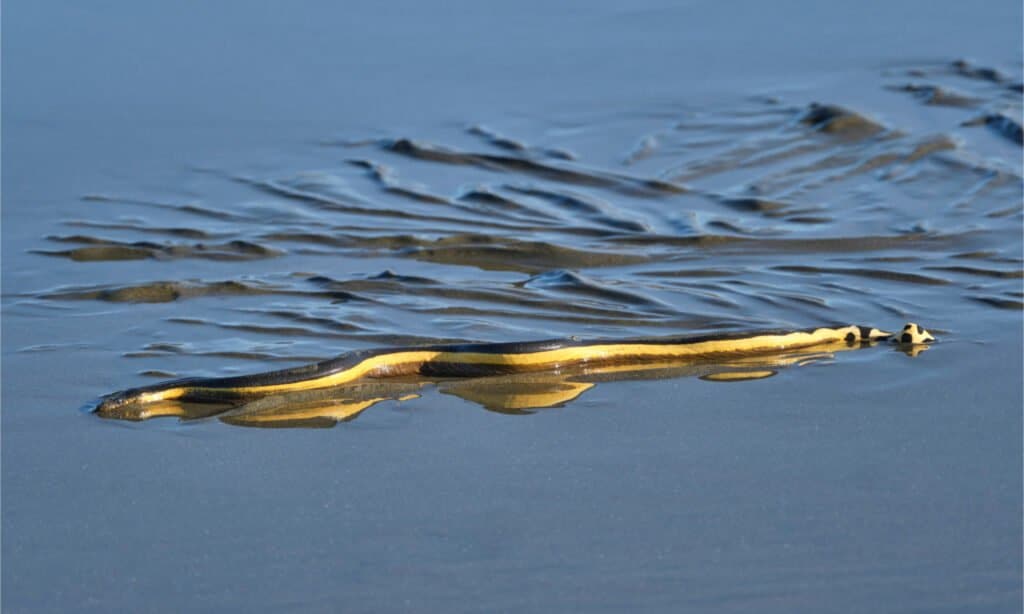
Yellow-bellied sea snakes spend time on land an in the water so be careful!
©John Fader/Shutterstock.com
The yellow-bellied sea snake can be found on land from time to time. However, it’s much more common in the water, and you must be aware of it. It’s easy to spot this snake on land because of its bright yellow underside, but it can be a bit trickier when you’re in the water. This is a long snake that often reaches 35 inches in length. The snake can stay under the water for up to three hours, so you could step near it and not know it. Sometimes, thousands of these snakes can be seen at the same time, as many of them will drift on the surface, waiting for prey.
The yellow-bellied sea snake is dangerous because its venom is a very potent neurotoxin that’s extremely harmful to humans. Although you should avoid them, the good news is that there has never been a human fatality at the hands of this snake, and they are a rather timid species.
8. Hawaiian Monk Seal
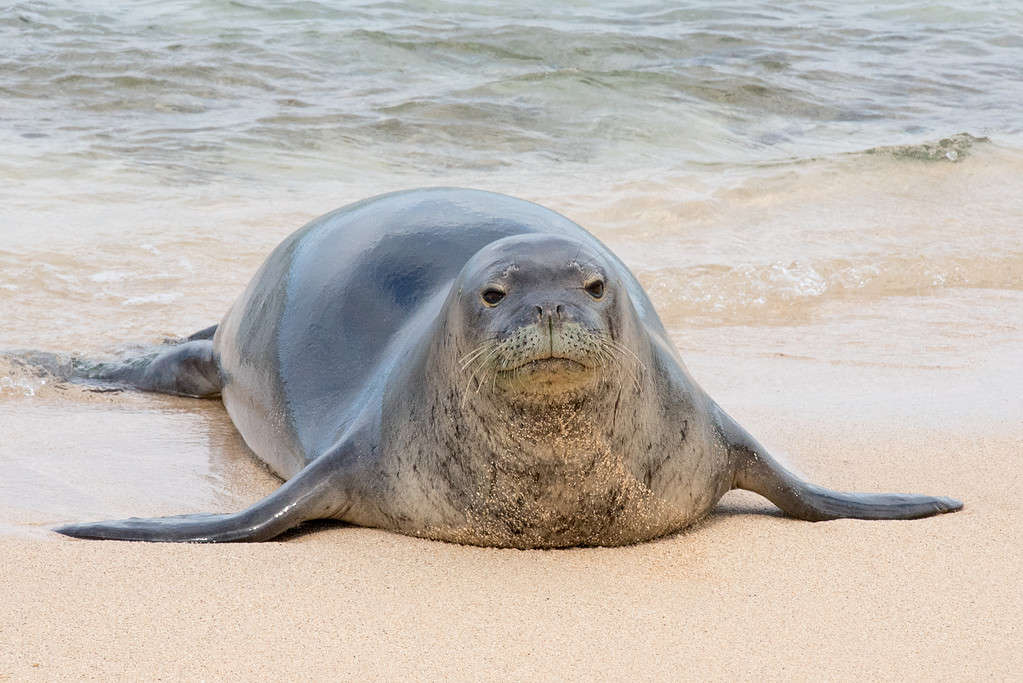
There are only 1,200 monk seals left in the world so be careful around them.
©Lorraine Logan/Shutterstock.com
Most people don’t think the monk seal is dangerous. In fact, it almost seems more cuddly than scary, but the monk seals have been pushed to the edge. There’s been a major epidemic affecting the health of the seals due to human encroachment and a lot of natural predators, and it’s been so bad that there are only 1,200 native monk seals left around the world.
That’s often why, when threatened, they will lash out. They typically won’t bite you, but they may try to rough you up with physical blows. You should probably stay away anyways, considering the fact that there’s a federal law that imposes up to 5 years in prison and a $50,000 fine if you disturb them in their habitat.
9. Hawaiian Stingray
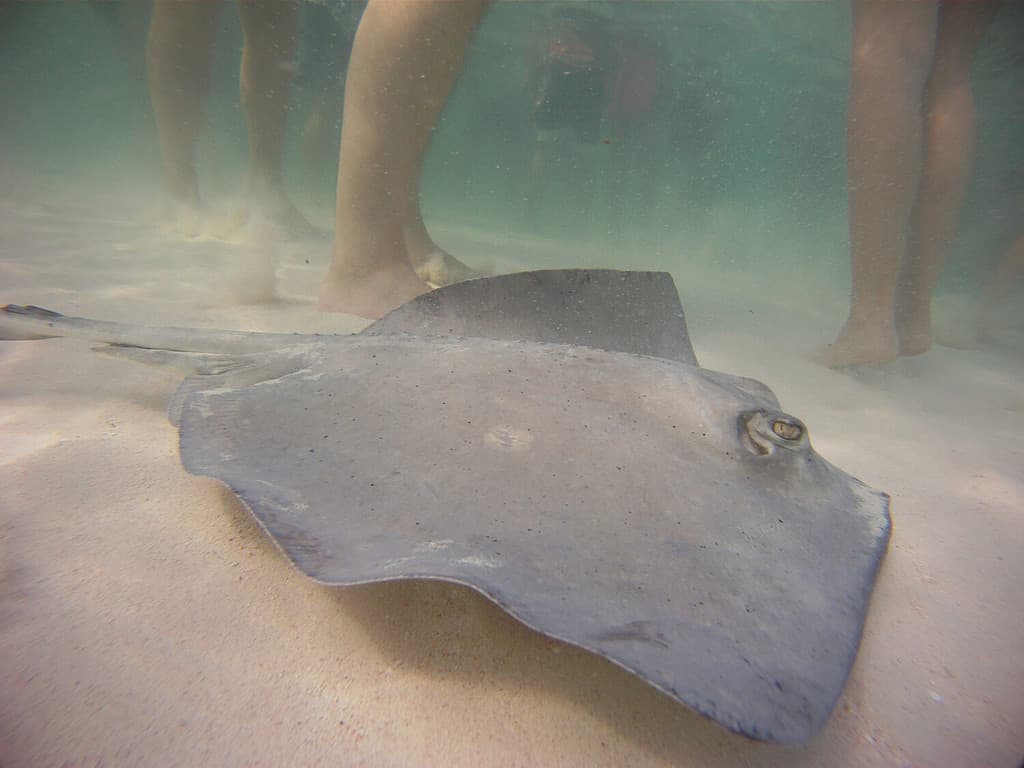
Stingrays won’t bother you unless they’re disturbed and if they are, they can be dangerous.
©Drop Zone Drone/Shutterstock.com
You should generally leave stingrays alone when they’re in their natural habitat, and this Hawaiian variation is no exception. Also known as the broad stingray, this variant has a long tail, huge wingspan, and a white belly. If they feel threatened, they may try to attack you with their tail, which is equipped with venomous spines, stinking barbs, and a venom gland. If it gets you, it could cause you to go into anaphylactic shock.
You’ll learn quickly that this is one of the most dangerous animals swimming in Hawaii’s oceans because if you bother it, the stingray will lift its stinger and shoot it over its head at you, and it may be too fast for you to avoid. If you go near one innocently, then it probably won’t attack, but it’s best not to try to bother this typically harmless creature.
10. Portuguese Man o’ War
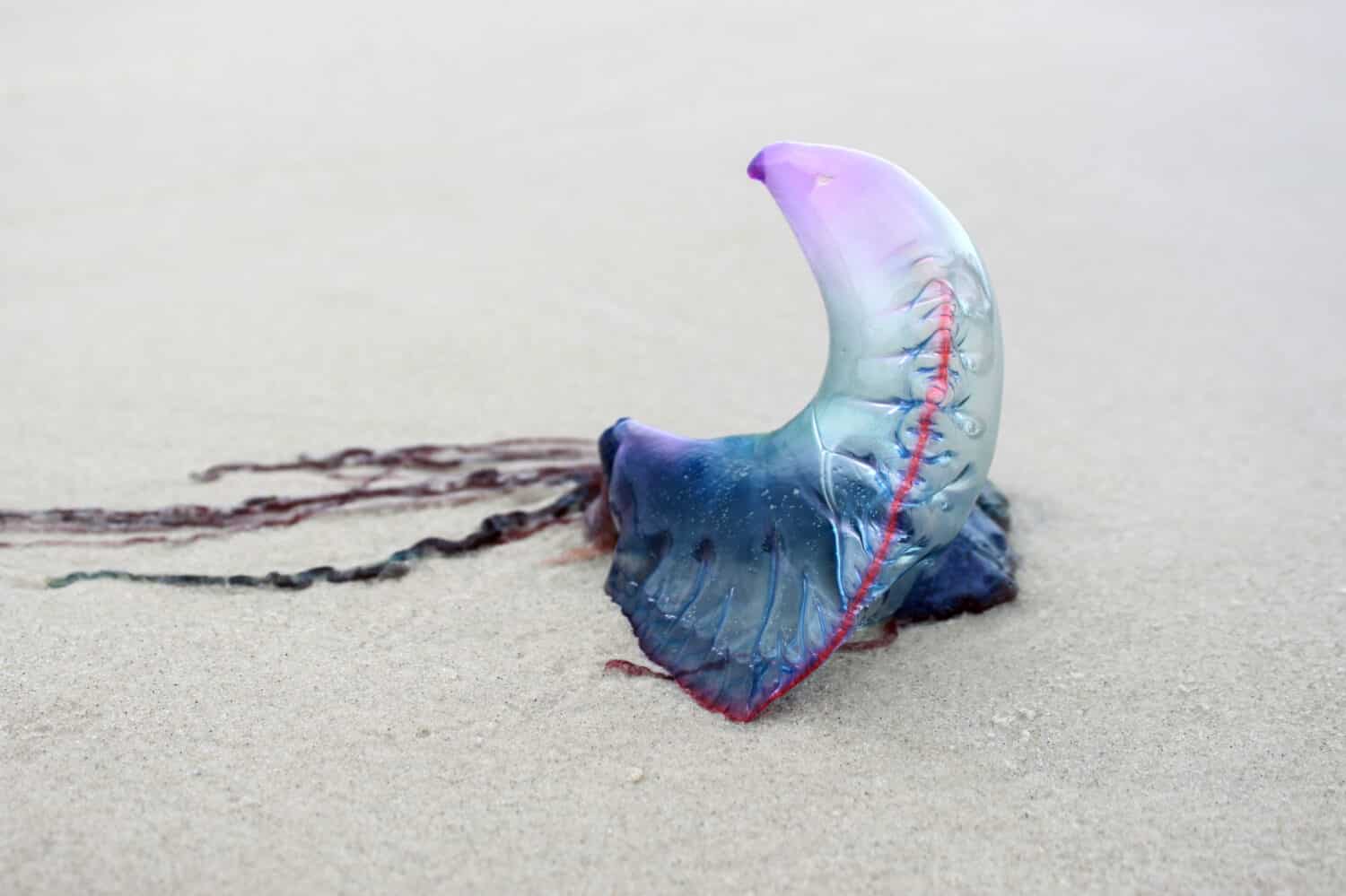
The man o’ war is dangerous in the water and when they wash up on land so watch your step.
©Pedro Sales Prado/Shutterstock.com
Similar to the jellyfish, the Portuguese man o’ war is another creature that may be beautiful when you see it in the aquarium, but in reality, it’s one of the most dangerous animals swimming in Hawaii’s oceans. The difference between this and the jellyfish is that the man o’ war lives underwater and on the surface, so it’s easier to accidentally run into them while you’re floating around. Even worse, a man o’ war often drifts up on shore, so if you’re not careful, you could easily step on it. Even if it’s dead, you could still be stung.
If you step on it or come in contact with it underwater and you touch one of its long tentacles, then you’ll get stung. One sting kills a fish upon contact, and it can cause major pain for a human. It likely will not kill you, but you should always watch your step when walking on the shores of Hawaii.
11. Hawaiian Lionfish

The lionfish comes out at night and has neuromuscular toxin in its fins.
Then, we have the Hawaiian lionfish, which looks both beautiful and threatening at the same time. There are two species, a red and a green, and you can spot them by the bright stripes on their body and the wing-like fins on its flanks. Those spiky fins are what makes the fish so dangerous because they protrude from the sides and its head. Those spikes contain a venom/neuromuscular toxin that is just like that of a cobra snake. The fins penetrate you or the fish, and then the toxin is released. When it comes to humans, the sting is not deadly, but it will cause pain, and you will swell a bit.
You may get lucky, but you typically won’t see the lionfish swimming about during the day because they’re likely hiding in caves and crevices. Instead, they typically come out during the night hours and feed on a diet of fish and crustaceans. This isn’t a long fish either, often coming in at about 16.5 centimeters, but if you do come in contact, you’ll definitely know it.
12. Crown of Thorns Starfish
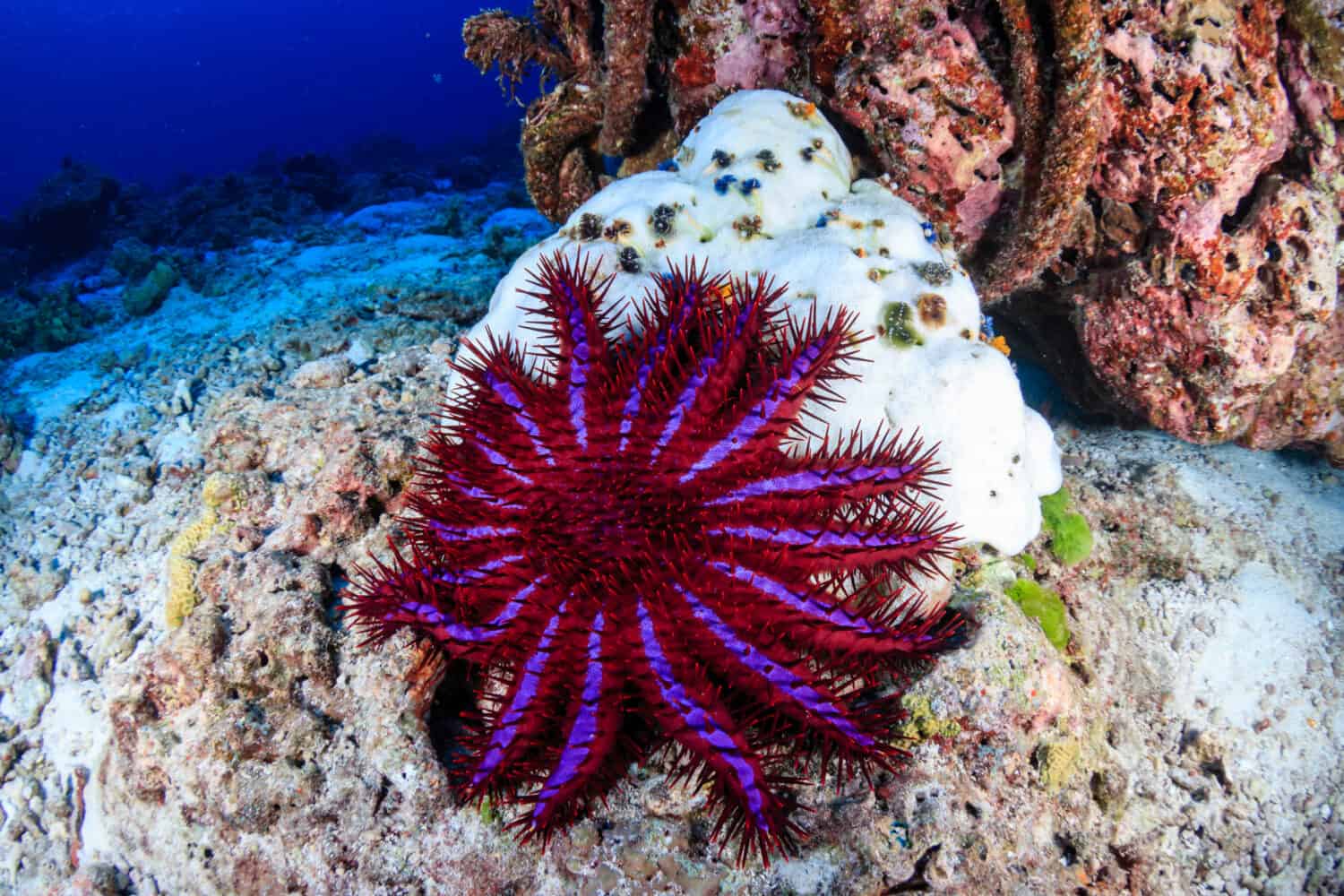
The Crown of Thorns Starfish can grow up to three feet in diameter.
©Richard Whitcombe/Shutterstock.com
Next, we have the crown of thorns starfish, which you will want to avoid at all costs. Though it has a general starfish appearance, this monstrous creature can grow up to 3 feet in diameter and have up to 19 huge appendages. All of those appendages are covered in spikes, and they can hurt if you step on them or lean against them.
This starfish is also harmful to the coral reefs that are so important to the health of the underwater ecosystem. The starfish feeds on the coral and destroys everything in its path. What’s worse is that the crown of thorns starfish reproduces very quickly, sometimes producing 60 million eggs. This starfish certainly won’t kill you, but when it comes to the environment of Hawaii, it’s certainly one of the most dangerous.
13. Barracuda
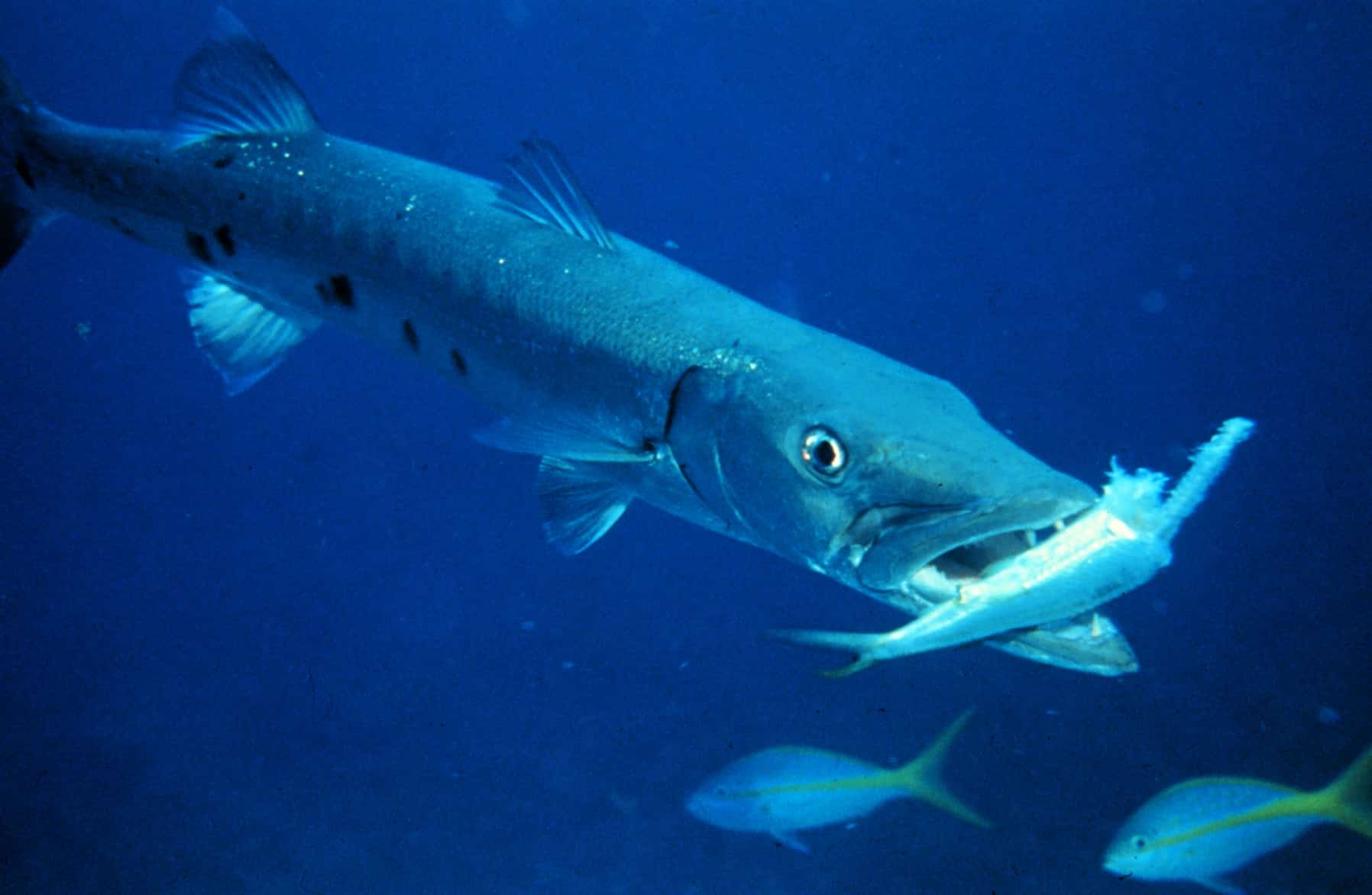
The barracuda doesn’t seem threatening but it can move swiftly at 40 feet per second.
©Florida Keys National Marine Sanctuary / Public domain, from Wikimedia Commons, the free media repository – License
Finally, we have the barracuda, which will come after humans from time to time. Barracudas are tricky because they like to float in the water and stay completely still as they spy on their prey from a distance. Although there are many different species of barracuda in the world, the one you’ll see in Hawaii can grow up to three feet, so you’ll have a good chance of spotting them. However, once they decide to go after their prey, many of them can swim up to 40 feet per second, so it can be a scary encounter. Luckily, barracuda attacks are very rare, so if you’re careful, you’ll be okay.
Conclusion
These are the 12 most dangerous animals swimming in Hawaii’s oceans. It can be daunting to think about how many species can cause you harm in a gorgeous island paradise, but if you’re careful, then you can avoid most of these animals and fish. Don’t let this convince you not to visit the gorgeous island of Hawaii at least once. If you’re still unsure, then stay at one of the resorts, and you’ll be in good hands.
The photo featured at the top of this post is © O'KHAEN/Shutterstock.com
Thank you for reading! Have some feedback for us? Contact the AZ Animals editorial team.







